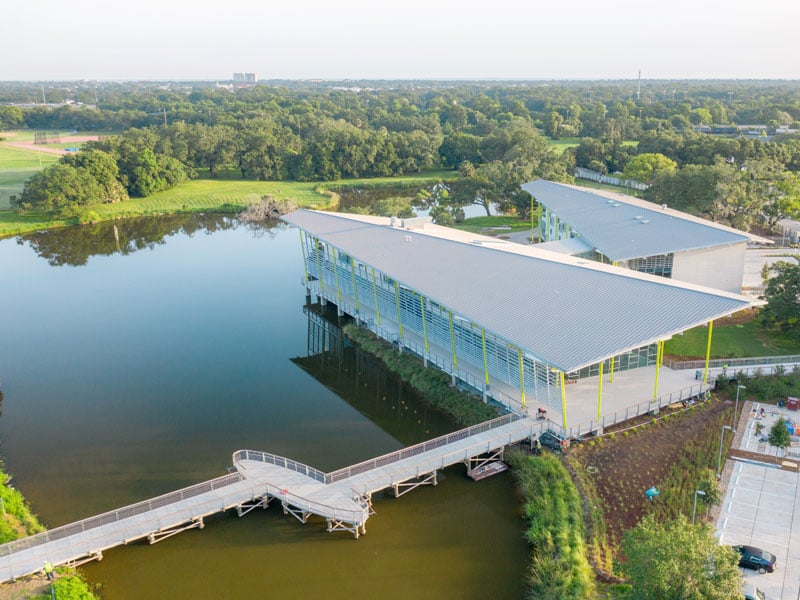Why Boardwalk Costs Vary So Dramatically
The reality: Every boardwalk project is unique, and understanding what drives these cost differences is essential for accurate budget planning.
The 8 Key Factors That Determine Your Boardwalk Cost
Rather than focus solely on one element , we've identified eight major factors that significantly impact project costs.
1. Project Size & Scale
Larger projects benefit from economies of scale, while smaller projects typically cost more per square foot due to fixed costs being spread over less area.
2. Geographic Location
Your project's distance from our precast concrete production facilities affects shipping costs, while regional labor rates can vary dramatically. A project in the Northeast might cost significantly more than the same structure in the Southeast.
3. Foundation Requirements
Often the single biggest cost driver, foundation type depends on soil conditions, environmental factors, and structural requirements.
4. Structure Height & Elevation
Higher boardwalks require more complex foundation design, potential installation labor impacts, specialized installation equipment, and additional safety measures which impact cost.
5. Boardwalk Width
6. Load Requirements
Load code requirements or special design considerations can impact the cost of the project.
See “load requirements” section below.
7. Site Access & Logistics
The proximity of the staging area to the boardwalk can impact installation costs.
See “site access & logistics” section below.
8. Construction Method
Traditional ground-up construction is most economical, while top-down installation methods can add to project costs.
See “construction method” section below.
In the sections below, we’ll dig into each of these eight factors.

Factor 1: Size & Scale
Size matters in boardwalk construction. Larger projects actually cost less per square foot than smaller ones, sometimes dramatically so. Bigger can mean more affordable.
This counterintuitive relationship exists because boardwalk projects have significant fixed costs that get spread across the total square footage. Whether you're building 200 square feet or 2,000 square feet, you still need geotechnical analysis, project management, equipment mobilization, and construction setup. The larger your project, the more area these fixed costs get distributed across.
Factor 2: Geographic Location
 Views from the PermaTrak boardwalk atop Pikes Peak at the award-winning Pikes Peak Summit Complex.
Views from the PermaTrak boardwalk atop Pikes Peak at the award-winning Pikes Peak Summit Complex.
Where your boardwalk project is located can significantly affect total installation costs through two primary mechanisms: shipping costs from our production facilities and regional labor rate differences.
Shipping Distance
PermaTrak's precast concrete components are manufactured at different production facilities across the United States. Rather than shipping everything from a single location, we seek to ship from a regional facility (if capacity allows).
That said, shipping distance can still play a role in your final project cost.
Labor Rates
Construction labor costs vary more dramatically across the country than many people realize. The same crew that installs your boardwalk for standard rates in rural Tennessee might command significantly higher wages for identical work in metropolitan Boston or San Francisco.
These differences reflect local market conditions, union presence, skill availability, and regulatory requirements. In some high-cost markets like New York City or the San Francisco Bay Area, labor premiums can add to your project cost compared to baseline markets.
Conversely, projects in lower-cost regions like rural Southeast markets or parts of Texas and the Midwest might actually see labor cost savings per square foot compared to national averages. For larger projects, these regional differences can translate to tens of thousands of dollars in cost variation.
Regional Cost Ranges:
- Southeast/Rural Texas: Often the most cost-effective
- Mid-Atlantic/Suburban Midwest: Normally closer to baseline
- Northeast Metro/West Coast: Premium markets
- Premium Metro Areas: Highest-cost markets
Other Location Factors
While shipping and labor represent the biggest location-based cost drivers, several other factors can affect your project budget depending on where you're building.
Permitting requirements vary between jurisdictions. Simple municipal permits might cost less than complex regulatory environments could require $5,000-10,000 or more in permit fees and consultant costs. For smaller projects, these differences can meaningfully impact cost per square foot.
Foundation materials also vary regionally. Concrete costs can fluctuate between regions based on local supply and demand. Steel availability affects pricing for driven pile foundations. Even timber costs vary significantly. What might be readily available Southern Yellow Pine in Georgia could require premium shipping costs for a project in Montana.
Some regions face seasonal construction limitations that can compress schedules and drive up costs. Northern climates often have winter restrictions that force projects into narrower construction windows. Hurricane-prone areas have weather considerations that can affect timing and logistics. These constraints can create cost premiums when projects must be completed on compressed schedules.
Factor 3: Boardwalk Foundations
As we say, “No two sites are the same.” One of the first steps in a boardwalk project’s design document phase is determining which foundation type will provide the most value within the owner’s allotted budget and specific application. For this reason, it’s important to get a geotechnical report as early in the process as possible.
Foundation costs are significant drivers of overall project costs as specified materials (timber, concrete, composite, or steel), construction methods and design requirements vary widely.
If you are looking to gather a project-specific boardwalk budget estimate, we encourage you to finish reading the information presented here, then request a boardwalk budget estimate. We will do our best to provide a detailed boardwalk construction cost estimate, specific to your location and project needs.
The eight most common foundation types used to support the PermaTrak boardwalk system:
-
Precast Concrete Piers (Supplied By PermaTrak)
-
Cast-In-Place Concrete Shallow Footings (Sonotube)
-
Timber Piles (Pressure Treated Southern Yellow Pine)
- Steel Helical Piles (Screw Piles)
-
Driven Steel Piles (H-pile or Pipe)
.png?width=800&height=700&name=Boardwalk%20Construction%20Estimates%20-%20Foundation%20Types%20-%20V2%20-%202025%20(1).png)
1. Precast Concrete Piers
These stackable pier components serve as a shallow foundation (spread footing) type of foundation.
If feasible, we recommend using this precast concrete pier system; it is the most cost-effective foundation option for a commercial boardwalk.
The piers are supplied as part of the PermaTrak system. PermaTrak boardwalks installed on this precast concrete pier system offer excellent value for commercial boardwalk projects.
The piers are supplied as part of the PermaTrak system. PermaTrak boardwalks installed on this precast concrete pier system offer excellent value for commercial boardwalk projects if used in the right environment.
Typical applications:
- Tree-root applications
- Less than 8 foot clear width
- Small spans, <10ft or less
- No frost concerns or depth
- Low to the ground
- Light loading
- Good bearing capacity (2,000 psf or better)
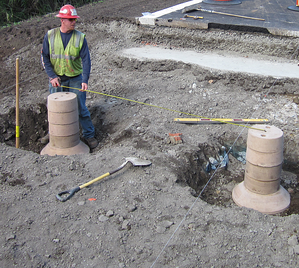
2. Cast-In-Place Concrete Shallow Footings
Shallow footings (#1-2) are preferred over deep footing options (#3-8) as they contribute to a lower boardwalk construction cost.
These cast-in-place footings could be circular or square. PermaTrak installed on a cast-in-place concrete shallow footing provides a cost-effective foundation solution for many projects.
This foundation is typically used when you have a decent bearing capacity and deep foundation is not required.
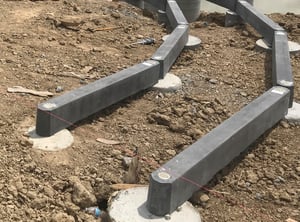
3. Timber Piles
Primarily due to their cost-effectiveness, pressure treated timber piles (aka timber poles) are the most common deep foundation option for commercial boardwalks. 12’’ diameter widths are often specified, while total pile length can be anywhere from 10–40’.
Several variables will impact the price of timber pile installation: site access, diameter of pile required, required driven depth, geographic region, total number of piles, soil conditions, etc.
Although these piles are supplied and installed by the contractor, we use historical data to estimate the total installation costs. Generally a PermaTrak boardwalk installed on a timber pile foundation offers competitive pricing for deep foundation applications.
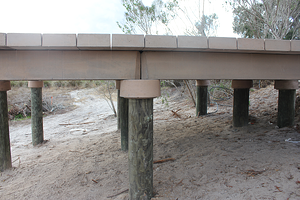
4. Drilled Shaft or Concrete Caissons
In northeastern states like Connecticut or Massachusetts, PermaTrak has been installed on a reinforced, concrete caisson. In Texas, drilled shaft foundations are common because of the expansive clay soils. This drilled shaft or concrete caisson method serves as a deep foundation option. PermaTrak boardwalks installed on a cast-in-place caisson system (deep foundation) provide excellent long-term value for challenging site conditions.
When designing a boardwalk on cast-in-place caissons, designers will consider site conditions, industry standard casing sizes, and finished boardwalk elevation (height above grade). All of these factors influence the structural engineer’s design for diameter and depth of the caissons. The photo here a multi-use path project shows a walking surface at roughly 5-6’ above grade.
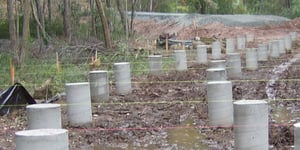
5. Steel Helical Piles (Screw Piles)
Steel helical piles, sometimes referred to as screw piles, provide several distinct advantages over timber or concrete foundations for your project site. Increasing in popularity and recognition, more designers are looking to helical piles as an environmentally friendly foundation option, especially if the boardwalk or pedestrian bridge needs to be installed in a sensitive wetland, or via top down construction.
The required diameter of the central steel shaft, and number and size of attached helices will influence the overall project cost for a PermaTrak boardwalk system installed on a steel helical pile foundation. Contact us for specific pricing based on your project requirements.
See an example of a PermaTrak project installed on helical piles here.
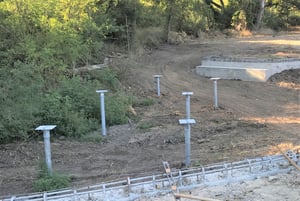
6. Fiberglass Composite Piles
Fiberglass composite piles have emerged as another cost-effective option to traditional deep foundation options described in #3 and #4 above. Fiberglass composite piles combine light weight with high capacity.
Additionally, fiberglass has a significantly longer design service life than either timber or steel in most environments. For most applications, a 10” or 12” diameter pile provides more than enough axial and lateral capacity. This foundation option offers competitive pricing while providing superior longevity compared to traditional materials.
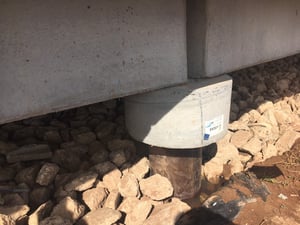
7. Driven Steel Piles (H-pile or Pipe)
A high capacity pile, this type is less common for boardwalks and pedestrian bridges. They may, however, serve as a durable deep foundation option if the project’s budget allows.
Pile size and required driven depth will influence the overall project cost for a PermaTrak boardwalk system installed on a driven steel pile foundation.
Contact us for specific pricing based on your project specifications.
8. Driven Concrete Piles
Less common than options #1–7, precast concrete piles provide a durable and long-lasting solution for deep foundation systems. When paired with the PermaTrak boardwalk system, they offer strong support and long-term performance in challenging site conditions.
Factor 4: Structure Height & Elevation

Your structure’s height impacts boardwalk design & construction. A boardwalk that sits 2 feet above grade operates under completely different cost dynamics than one 20 feet above a wetland.
As structures climb higher, costs often increase based on a variety of factors: foundations grow more complex, installation becomes more difficult, and safety requirements multiply both time and equipment needs.
The most significant cost impact occurs below ground. Once structures reach a certain height, they typically require deep foundations like driven piles, drilled shafts, or helical piers. These systems often need larger diameters and great depths.
Installation equipment requirements also escalate with height. Elevated structures often require larger equipment. Material handling becomes more complex at height, and installation crews must work more slowly and methodically, reducing productivity and increasing labor hours per square foot.
Safety requirements often become a factor with highly elevated boardwalks as OSHA requires fall protection for work over 6ft.
Factor 5: Boardwalk Width
Here's where PermaTrak's design advantage shines: our 2-beam system means wider boardwalks are actually more cost-effective per square foot.
Unlike traditional timber boardwalks that require stringers every 12-16 inches regardless of width, PermaTrak uses just two longitudinal beams for any width from 4 feet to 15.5 feet. This creates significant cost efficiencies as width increases because the same beam costs get distributed over more square footage.
A 6-foot-wide boardwalk might have a moderate cost per square foot, while a 12-foot-wide boardwalk using the identical beam system could cost less per square foot. The wider structure maximizes beam utilization and installation efficiency, making it the more economical choice on a per-square-foot basis.
This efficiency advantage becomes even more pronounced on larger projects where the wider boardwalk approach can yield substantial total cost savings while providing enhanced user experience and accessibility.
Factor 6: Load Requirements

PermaTrak designs to AASHTO standards, which specify vehicle load requirements based on the clear width of your boardwalk. For most projects, following these standard load requirements doesn't add cost – it's built into our baseline design.
However, when projects require loads beyond standard AASHTO specifications, costs can increase.
Special Load Requirements

Special load requirements like concrete trucks, H15 or H20 loading, or custom equipment access need to be discussed upfront because they directly impact both beam capacity and foundation design. These heavier loads require larger beam sections, stronger connections, and more robust foundation systems.
Top-down construction methods usually require equipment that exceeds AASHTO standards, necessitating structural upgrades to accommodate installation cranes and specialized equipment.
Projects in seismic areas require additional design considerations for lateral forces, while regions with significant snow loads add substantial weight to the structure. Our South Tahoe project, for example, required design for 12 feet of snow loading, which significantly impacted both precast component sizing and foundation requirements.
Snow loading in mountainous or northern climates can affect structural requirements. Unlike temporary loads, snow represents a sustained load that must be carried for extended periods, often requiring larger beam sections and more robust foundations.
Factor 7: Site Access & Logistics

Site access impacts boardwalk installation costs, with material staging distance being one of the most significant factors. The closer you can stage materials to the actual boardwalk installation points, the more you'll benefit from reduced installation costs. When materials can be delivered directly to the work area, installation crews can focus on assembly rather than transportation, maximizing productivity and minimizing labor hours.
When staging areas are located far from installation points, costs escalate because crews can spend more time moving equipment and materials rather than installing boardwalk components. Distant staging may require different or additional equipment beyond what's needed for installation. You might need equipment dedicated to shuttling materials to the site while separate equipment handles the actual boardwalk assembly.
Projects with excellent access where trucks can deliver directly to work areas represent the most cost-effective scenario, while remote installations requiring hand-carry or specialized transport can significantly impact your budget.
Factor 8: Construction Method

Environmental regulations often driving the need for specialized installation techniques. The method you're required to use can impact your project costs compared to standard construction approaches.
Traditional Construction (Ground-Up)
Traditional construction allows equipment to access the site from ground level, using standard installation procedures throughout the project. Foundations are installed from the ground using conventional equipment like drill rigs or pile drivers, then boardwalk components are assembled from the completed foundation system up.
This represents the most cost-effective construction method and serves as the baseline for comparing other approaches. Equipment can be staged efficiently, crews can work at maximum productivity, and installation proceeds in the most logical sequence.
Partial Top-Down Construction
Partial top-down construction allows foundations to be installed from ground level using mats to minimize environmental impact, but requires boardwalk installation from completed sections using smaller equipment.
This method typically costs more than traditional construction due to equipment limitations and reduced installation efficiency.
While foundation installation can use larger, more efficient equipment, the boardwalk assembly must be performed by smaller machines operating from the structure itself, requiring specialized load distribution and slower installation procedures.
Full Top-Down Construction
Full top-down construction requires all work to be performed from above existing structure, with both foundations and boardwalk components installed using equipment that operates entirely from the boardwalk surface.
For more information about top-down construction, check out our article How to Build a Boardwalk Over Wetlands: Top-Down Construction.
What the PermaTrak System Includes
The boardwalk cost estimates listed above include production and shipment to the job site of the following PermaTrak components:
-
Precast concrete pier system (if applicable) – consists of a base, riser(s) and cap
-
Reinforced, precast concrete beams – replacement for stringers, runners, headers, and/or joists from a traditional timber boardwalk system
-
Reinforced, precast concrete treads – replacements for planks or boards on a timber boardwalk system
-
Internal polyurethane connector pins as required
-
Rubber bearing pad – to be laid on top of beams prior to tread installation
-
Integral color for all precast concrete elements
-
Integral form liner finish for all tread walking surfaces
-
Connection hardware & bearing pads
*Note: See our PermaTrak Components page for a schematic drawing of our boardwalk system with these components. Or you can learn more about a PermaTrak boardwalk installation process to see how these components are installed.*
Also included in these price considerations are the following:
-
Engineering and site-specific design support
-
Detailed construction documents and shop drawings submitted by a registered P.E.
You can read an article with more information on what this engineering support includes.
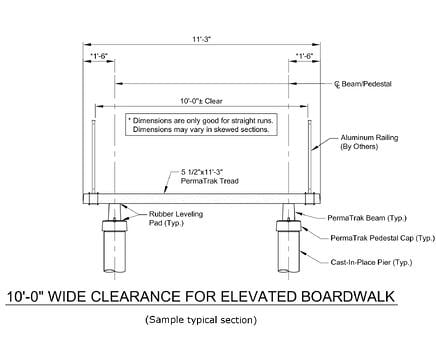
Longer Spans with Concrete Beams = Less Footings = Potential Cost Savings
Other recent projects have shown this same result: a concrete boardwalk costs less than a timber boardwalk. How can this be possible? The answer is that PermaTrak's precast concrete beams can span at least twice the length of a timber stringer or "runner". Installed costs can vary widely by project and longer spans don't always make for the best design option.Design Assumptions and the Evaluation Process
Feel free to request a more specific budget estimate by clicking here, or give us a call and we will do our best to help with more technical information on the foundations described above.
We understand how much work goes into the evaluation process for commercial boardwalk materials: initial costs, the owner’s experience with other materials, constructability, associated maintenance costs, etc. Hopefully this information is helpful as your project develops into design and construction documents.

